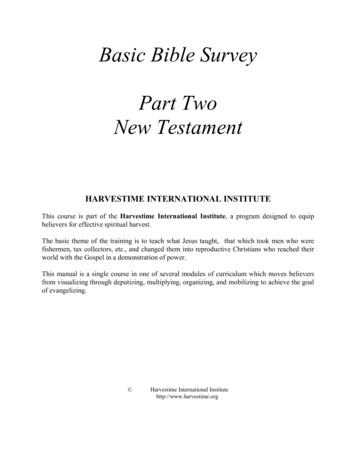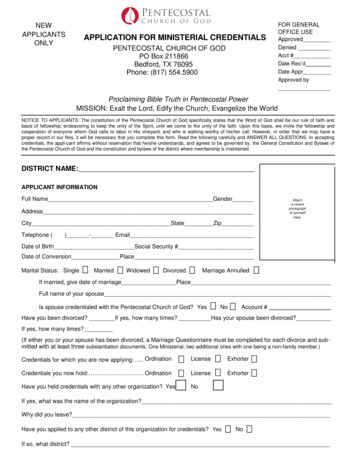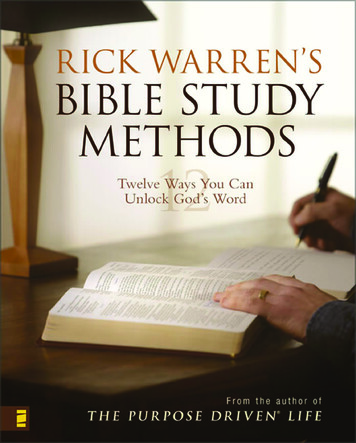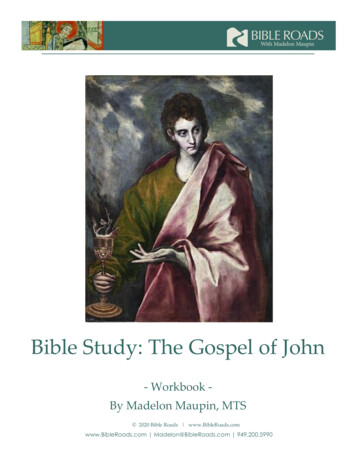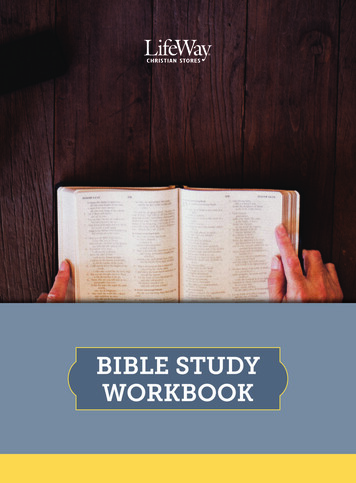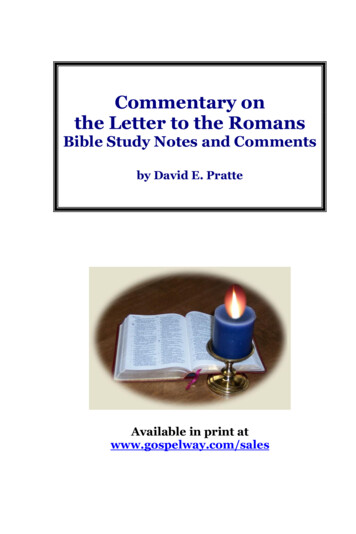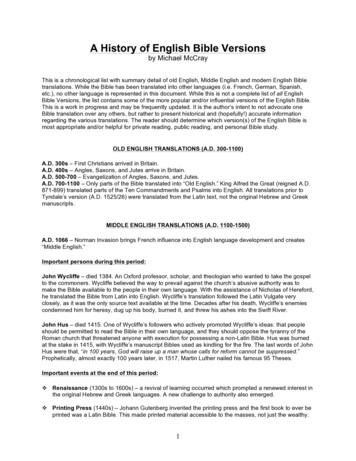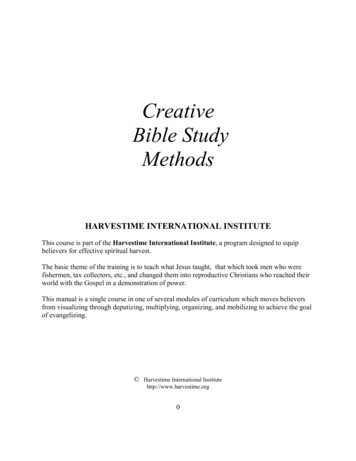
Transcription
CreativeBible StudyMethodsHARVESTIME INTERNATIONAL INSTITUTEThis course is part of the Harvestime International Institute, a program designed to equipbelievers for effective spiritual harvest.The basic theme of the training is to teach what Jesus taught, that which took men who werefishermen, tax collectors, etc., and changed them into reproductive Christians who reached theirworld with the Gospel in a demonstration of power.This manual is a single course in one of several modules of curriculum which moves believersfrom visualizing through deputizing, multiplying, organizing, and mobilizing to achieve the goalof evangelizing. Harvestime International Institutehttp://www.harvestime.org0
1
TABLE OF CONTENTSHow To Use This Manual.Suggestions For Group Study .Course Introduction .Course Objectives.3457.82139.4557677589PART ONE: THE SUBJECT OF STUDY1. Introducing The Bible.2. The Books Of The Bible .3. Versions Of The Bible .PART TWO: PREPARATION FOR STUDY4.5.6.7.8.Before You Begin .Bible Study Tools .Principles Of Interpretation.Bible Background .Outlining, Marking, And Charting.PART THREE: CREATIVE BIBLE g The Bible By The BibleDevotional Bible Study. .Book Study.Chapter Study .Paragraph Study .Verse Study.Word Study.Topical Bible Study.Biographical Study.The Theological Method .Studying Bible Poetry .Studying Bible Prophecy .The Typological Method .Appendix.Answers To 2302332
HOW TO USE THIS MANUALMANUAL FORMATEach lesson consists of:Objectives: These are the goals you should achieve by studying the chapter. Read them beforestarting the lesson.Key Verse: This verse emphasizes the main concept of the chapter. Memorize it.Chapter Content: Study each section. Use your Bible to look up any references not printed inthe manual.Self-Test: Take this test after you finish studying the chapter. Try to answer the questionswithout using your Bible or this manual. When you have concluded the Self-Test, check youranswers in the answer section provided at the end of the book.For Further Study: This section will help you continue your study of the Word of God,improve your study skills, and apply what you have learned to your life and ministry.Final Examination: If you are enrolled in this course for credit, you received a finalexamination along with this course. Upon conclusion of this course, you should complete thisexamination and return it for grading as instructed.ADDITIONAL MATERIALS NEEDEDYou will need a King James version of the Bible.3
SUGGESTIONS FOR GROUP STUDYFIRST MEETINGOpening: Open with prayer and introductions. Get acquainted and register the students.Establish Group Procedures: Determine who will lead the meetings, the time, place, and datesfor the sessions.Praise And Worship: Invite the presence of the Holy Spirit into your training session.Distribute Manuals To Students: Introduce the manual title, format, and course objectivesprovided in the first few pages of the manual.Make The First Assignment: Students will read the chapters assigned and take the Self-Testsprior to the next meeting. The number of chapters you cover per meeting will depend on chapterlength, content, and the abilities of your group.SECOND AND FOLLOWING MEETINGSOpening: Pray. Welcome and register any new students and give them a manual. Takeattendance. Have a time of praise and worship.Review: Present a brief summary of what you studied at the last meeting.Lesson: Discuss each section of the chapter using the HEADINGS IN CAPITAL BOLDFACED LETTERS as a teaching outline. Ask students for questions or comments on what theyhave studied. Apply the lesson to the lives and ministries of your students.Self-Test: Review the Self-Tests students have completed. (Note: If you do not want thestudents to have access to the answers to the Self-Tests, you may remove the answer pages fromthe back of each manual.)For Further Study: You may do these projects on a group or individual basis.Final Examination: If your group is enrolled in this course for credit, you received a finalexamination with this course. Reproduce a copy for each student and administer the exam uponconclusion of this course.4
MODULE:COURSE:DeputizingCreative Bible Study MethodsINTRODUCTIONThe New Testament Prophet John the Baptist was known as a "voice crying in the wilderness" ashe proclaimed the Word of God. His message was fresh, powerful, and relevant to the spiritualneeds of his time.Many people today have become echoes of spiritual truths they hear from those around them.They are not a voice through which God can reveal His message, but are only an echo of whatthey hear from others. They are like the prophets of whom God said, "steal my words every onefrom his neighbor" (Jeremiah 23:30).In order to speak God's words you must first know what God has said. The purpose of this courseis to equip you to understand God's Word. You will need only this manual, a Bible, and theguidance of the Holy Spirit to learn these "Creative Bible Study Methods."A method is an organized way to accomplish something. It is an orderly plan. Bible studymethods are an organized plan to study God's written Word. The word "creative" means "havingthe ability to produce that which is new." This course teaches you how to study God's Word foryourself. You will not have to rely on the research of others because you will be able to createyour own Bible studies based on your study of God's written Word.By learning proper Bible study methods you will become a voice through which God can speakHis truths to a spiritually hungry world. You will no longer only be an echo of what you hearfrom others."Creative Bible Study Methods" introduces the Bible as the written Word of the one true God. Itexplains divisions of the Bible, versions, translations, and paraphrases. First, the course guidesyou to discover what the Bible teaches about itself, then creative methods are explained and youare given the opportunity to use each method discussed.The course also explains how to outline, make study notes, mark your Bible for easy reference,and reduce lengthy passages to simple charts. The course guides you to proper interpretation andapplication of God's Word. It directs attention to the greatest Teacher of all, the Holy Spirit. Ifyou follow the guidelines presented, you will experience a new, creative spiritual life flowingwithin you.5
No method of Bible study can replace the teaching ministry of the Holy Spirit. He is the spiritualforce that endues a method with creative power. He whispers into the human spirit the truths ofGod's Word which create a new spiritual life flow.The study of methods is not an end in itself. It is not the final goal. The methods are only ameans to accomplish the objective of studying God's Word. It is not enough to learn thesemethods. You must use what you learn to study God’s Word and apply its truths to your life andministry.Although you may complete the lessons in this manual, in reality you will never really completethis course. Your study of God's Word will never be finished because its rich spiritual truths cannever be exhausted.Note: This course teaches Bible study methods, not Bible content. Harvestime International Institute offers anothercourse entitled "Basic Bible Survey" which presents the general background of the Bible, an outline of each book, itsauthor, time of writing, to whom it was written, purpose, key verse, important characters, maps, dates, and chartssummarizing general Bible content. Because of the need for a general introduction to the Bible in both Bible studyand Bible survey, the first three chapters of these courses are identical while the remaining content differs.6
COURSE OBJECTIVESUpon completion of this course you will be able to: Explain how the Bible originated. Describe the organization of the Bible into testaments, major divisions, and books. Summarize basic history and chronology of the Bible. Explain the unity and diversity of the Bible. Explain how different Bible versions developed. Apply rules for proper interpretation of the Bible. Summarize what the Bible teaches about itself. Identify prerequisites for Bible study. Create outlines, charts, summaries, and text markings to help you retain content. Apply creative methods to your study of God's Word. Use Bible study tools.7
PART ONE: THE SUBJECT OF STUDYCHAPTER ONEINTRODUCING THE BIBLEOBJECTIVES:Upon completion of this chapter you will be able to: Write the Key Verse from memory.Define the word "Bible."Define the word "Scripture."Explain the origin of the Bible.Identify the major purposes of the Bible.Identify the Old and New Testaments as the two major divisions of the Bible.Name the four divisions of Old Testament books.Name the four divisions of New Testament books.Explain what is meant by the "unity and diversity" of the Bible.Identify the person upon whom the revelation of both testaments center.KEY VERSES:All Scripture is given by inspiration of God, and is profitable for doctrine,for reproof, for correction, for instruction in righteousness:That the man of God may be perfect, thoroughly furnished unto all goodworks. (II Timothy 3:16-17)INTRODUCTIONThis chapter introduces the Bible which is the written Word of the one true God. The word"Bible" means "the books." The Bible is one volume which consists of 66 separate books.The word "Scripture" is also used to refer to God's Word. This word comes from a Latin wordwhich means "writing." When the word "Scripture" is used with a capital "S" it means the sacredwritings of the one true God. The word "Bible" is not used in the Bible. It is a word used bymen as a title for all of God's Words.8
ORIGIN OF THE BIBLEThe Bible is the written Word of God. He inspired the words in the Bible and usedapproximately 40 different men to write down His words. These men wrote over a period of1500 years. The perfect agreement of these writers is one proof that they were all guided by asingle author. That author was God.Some of the writers wrote down exactly what God said:Take thee a roll of a book, and write therein all the words that I have spokenunto thee against Israel . . . (Jeremiah 36:2)Other writers wrote what they experienced or what God revealed concerning the future:Write the things which thou hast seen, and the things which are, and thethings which shall be hereafter. (Revelation 1:19)All of the writers wrote under God's inspiration the words of His message for us.THE PURPOSE OF THE BIBLEThe Bible itself records its main purpose:All Scripture is given by inspiration of God, and is profitable for doctrine,for reproof, for correction, for instruction in righteousness:That the man of God may be perfect, thoroughly furnished unto all goodworks. (II Timothy 3:16-17)The Scriptures are to be used to teach doctrine, to reprove and correct from evil, and to teachrighteousness. They will help you live right and equip you to work for God.MAJOR DIVISIONSThe Bible is divided into two major sections called the Old Testament and the New Testament.The word "testament" means “covenant.” A covenant is an agreement. The Old Testamentrecords God's original covenant or agreement with man. The New Testament records the newcovenant made by God through His Son, Jesus Christ.What was the subject of these two agreements? They both concerned restoring sinful man toright relationship with God. God made a law that sin can only be forgiven through the sheddingof blood:. . . without shedding of blood is no remission (forgiveness). (Hebrews 9:22)9
Under God's agreement in the Old Testament, blood sacrifices of animals were made by man toobtain forgiveness for sin. This was a symbol of the blood sacrifice Jesus Christ would provideunder the new agreement with God. Through the birth, life, death, and resurrection of Jesus, afinal sacrifice for sin was made:But Christ being come an high priest of good things to come, by a greaterand more perfect tabernacle, not made with hands, that is to say, not of thisbuilding;Neither by the blood of goats and calves, but by His own blood He entered inonce into the holy place, having obtained eternal redemption for us.For if the blood of bulls and of goats, and the ashes of an heifer sprinklingthe unclean, sanctifieth to the purifying of the flesh:How much more shall the blood of Christ, who through the eternal Spiritoffered Himself without spot to God, purge your conscience from dead worksto serve the living God?And for this cause He is the mediator of the new testament, that by means of death,for the redemption the transgressions that were under the first testament, theywhich are called might receive the promise of eternal inheritance.(Hebrews 9:11-15)Both testaments are the Word of God and we must study both in order to understand God'smessage. The terms "old" and "new" testaments are used to distinguish between God'sagreement with man before and after the death of Jesus Christ. We do not disregard the OldTestament simply because it is called "old."FURTHER DIVISIONSThe Bible is further divided into 66 books. The Old Testament has 39 books. The NewTestament contains 27 books. Each book is divided into chapters and verses. Although thecontent of each book is the Word of God, the division into chapters and verses was made by manto make it easy to locate specific passages. It would be very difficult to find a passage if thebooks were all one long paragraph.Here is a simple diagram that shows the basic divisions of the Bible:10
THE BIBLEOld Testament39 BooksNew Testament27 BooksUNITY OF THE BIBLEWhen we speak of the unity of the Bible, we mean two things:ONE: THE BIBLE IS UNITED IN CONTENT:Even though the Bible was written by many writers over many years, there are no contradictions.One author does not contradict any of the others. The Bible includes discussion of hundreds ofcontroversial subjects. (A controversial subject is one that creates different opinions whenmentioned). Yet the writers of the Bible spoke on such subjects with harmony from the firstbook of Genesis through the last book of Revelation. This was possible because there was reallyonly one author: God. The writers only recorded the message under His direction andinspiration. For this reason, the content of the Bible is united.TWO: THE BIBLE IS UNITED IN THEME:Some people think the Bible is a collection of 66 separate books on different subjects. They donot realize that the Bible is united by a major theme. From beginning to end, the Bible revealsGod's special purpose which is summarized in the book of Ephesians:Having made known unto us the mystery of His will, according to His goodpleasure which He hath purposed in Himself:That in the dispensation of the fullness of times He might gather together inone all things in Christ, both which are in heaven, and which are on earth;even in Him:In whom also we have obtained an inheritance, being predestinatedaccording to the purpose of Him who worketh all things after the counsel ofHis own will. (Ephesians 1:9-11)The Bible reveals the mystery of God’s plan which is the unifying theme of the Bible. It is therevelation of Jesus Christ as the Savior of sinful mankind. Jesus explained how the OldTestament centered on Him:And He said unto them, These are the words which I spake unto you while Iwas yet with you, that all things must be fulfilled, which were written in the11
law of Moses, and in the prophets, and in the psalms concerning me.(Luke 24:44)With this introduction, Jesus continued and . . . . . opened He their understanding that they might understand the scriptures.(Luke 24:45)What was the key Jesus gave them to understanding the Scriptures? The fact that its majortheme focused on Him:. . . Thus it is written, and thus it behooved Christ to suffer, and to rise fromthe dead the third day:And that repentance and remission of sins should be preached in Hisname among all nations, beginning at Jerusalem. And Ye are witnesses ofthese things. (Luke 24:46-48)The Old and New Testaments both tell the story of Jesus. The Old Testament prepares us for itshappening and the New Testament tells how it happened. This unites the Bible in one majortheme. The people who looked forward to Jesus under the Old Testament were saved from theirsins through faith in God's promise. Everyone who looks back to it as having been fulfilled inJesus Christ is saved in the same way: Through faith that it happened just as God promised.DIVERSITY OF THE BIBLEWhen we speak of the "diversity" of the Bible we mean that the Bible has variety. It recordsdifferent ways in which God dealt with people and the different ways in which they responded toHim.The Bible is written in different moods. Some portions express joy while others reflect sorrow.The Bible includes different types of writing. It contains history, poetry, prophecy, letters,adventure, parables, miracles, and love stories. Because of its variety, the Bible has been furtherdivided into major groups of books.OLD TESTAMENT DIVISIONSThe books of the Old Testament are divided into four major groups: Law, history, poetry andprophecy.12
THE BOOKS OF THE LAW:There are five books of law. The names of these books are:GenesisExodusLeviticusNumbersDeuteronomyThese books record the creation of man and the world by God and the early history of man.They tell how God raised up the nation of Israel as a people through which He could revealHimself to the nations of the world.These books record the laws of God. The best known parts are the Ten Commandments (Exodus20:3-17), the greatest of all commandments (Deuteronomy 6:5), and the second greatestcommandment (Leviticus 19:18).Open your Bible and locate the books of Law in the Old Testament. Locate the three versesmentioned in the preceding paragraph and read them. These are an example of the laws of Godrecorded in these books.THE BOOKS OF HISTORY:There are 12 books of history in the Old Testament. The names of the books of history are:JoshuaJudgesRuthI and II SamuelI and II KingsI and II ChroniclesEzraNehemiahEstherLocate these books in your Bible. They are found right after the books of law. The books ofhistory cover a thousand year history of God's people, Israel. Naturally they do not telleverything that happened, but they record the major events and show the results of bothfollowing and ignoring God's law.13
THE BOOKS OF POETRY:There are five books of poetry. The names of the books of poetry are:JobPsalmsProverbsEcclesiastesSong of SolomonThese books are the worship books of God's people, Israel. They still are used in worship bybelievers today. Turn to Psalm 23 and read it. This is an example of the beautiful worship poetrycontained in these books.THE BOOKS OF PROPHECY:The books of prophecy of the Old Testament are divided into two groups which are called Majorand Minor prophetical books. This does not mean the Major Prophets are more important thanthe Minor Prophets. The title is simply used because the Major Prophets are longer books thanthe Minor Prophets. There are 17 books of prophecy in the Old Testament. The names of thebooks of prophecy are:Major nor ukZechariahHaggaiZechariahMalachiThese books are prophetic messages from God to His people about future events. Many of theprophecies have already been fulfilled, but some remain to be fulfilled in the future. Find theseprophetic books in your Bible. They are the last books in the Old Testament.14
NEW TESTAMENT DIVISIONSThe New Testament has also been divided into four groups: Gospels, History, Letters, andProphecy.THE GOSPELS:There are four books in the Gospels. The names of these books are:MatthewMarkLukeJohnThese books tell about the life, death, and resurrection of Jesus. Their purpose is to lead you tobelieve that He is the Christ, the Son of God. Find the Gospels in your Bible and then read John20:31 which states this purpose.THE BOOK OF HISTORY:There is one book of history in the New Testament, the book of Acts. This book tells how thechurch began and fulfilled Christ's commission to spread the Gospel throughout the world.Locate this book in your Bible.LETTERS:There are 21 letters in the New Testament. The names of these letters are:RomansTitusI and II hilippiansI and II PeterColossiansI, II, and III JohnI and II ThessaloniansJudeI and II TimothyThe letters are addressed to all believers. Their purpose is to guide them in living and help themdo what Jesus commanded. Romans 12 is a good example of their teaching. Turn to this chapterin your Bible and read it. The letters are also sometimes called "epistles" which means letters.PROPHECY:Revelation is the only book of prophecy in the New Testament. It tells of the final victory ofJesus and His people. Its purpose is to encourage you to keep living as aChristian should live until the end of time. Its message is summarized in Revelation 2:10.15
SELF-TEST1.Write the Key Verses from memory:2.What does the word "Bible" mean?3.What does the word "Scripture" mean?4.What are the two major divisions of the Bible?5.How many books are there in the Bible?6.Name the four major groups into which Old Testament books are divided:7.8.Name the four major groups into which New Testament books are divided:What is the meaning of the word "testament"?16
9.What are four main purposes of the Bible? Give a Bible reference to support youranswer.10.What is meant by the "unity of the Bible"?11.What is meant by the "diversity of the Bible"?12.Read each statement. If the statement is TRUE put the letter T on the blank in front of it.If the statement is FALSE put the letter F on the blank in front of it:a. The Bible is the written Word of the one true God.b. Although God inspired the Bible, He used men to write down His words.c. Because there were many writers over a period of many years, the Biblecontains a lot of contradictions.d. There is no united theme of the Bible. It is just a collection of books ondifferent subjects.e. The Major Prophets of the Old Testament are more important than theMinor Prophets.13.Who is the person on which the revelation of both testaments centers? Give a Biblereference to support your answer. Reference(Answers to tests are provided at the conclusion of the final chapter in this manual.)17
FOR FURTHER STUDYThe bookmarks on the next page will help you learn the major divisions of the Bible. Cut out thebookmarks on the lines dividing them and place them in your Bible. If you have difficulty inlocating the place to insert your bookmarks, use the Table of Contents in the front of your Bible.It lists the books in the order in which they appear in the Bible. It also provides the page numberwhere each book begins.OLD TESTAMENTPlace bookmark 1 at the beginning of the book of Genesis.Place bookmark 2 at the beginning of the book of Joshua.Place bookmark 3 at the beginning of the book of Job.Place bookmark 4 at the beginning of the book of Isaiah.NEW TESTAMENTPlace bookmark 5 at the beginning of the book of Matthew.Place bookmark 6 at the beginning of the book of Acts.Place bookmark 7 at the beginning of the book of Romans.Place bookmark 8 at the beginning of the book of Revelation.You have now located the major divisions of the Bible. Keep using the bookmarks until you canname and locate these divisions by memory.18
OLD TESTAMENTLAWOLD TESTAMENTHISTORYOLD ONOMYJOSHUAJUDGESRUTHI SAMUELII SAMUELI KINGSII KINGSI CHRONICLESII SIASTESSONG OF SOLOMONOLD TESTAMENTPROPHECYMAJOR NOR UKZECHARIAHHAGGAIZECHARIAHMALACHIOLD TESTAMENT BOOK MARKS19
NEW TESTAMENTGOSPELSNEW TESTAMENTHISTORYMATTHEWMARKLUKEJOHNACTSNEW TESTAMENTLETTERSROMANSI CORINTHIANSII I THESSALONIANSII THESSALONIANSI TIMOTHYII TIMOTHYTITUSPHILEMONHEBREWSJAMESI PETERII PETERI JOHNII JOHNIII JOHNJUDENEW TESTAMENTPROPHECY (1)REVELATIONNEW TESTAMENT BOOK MARKS20
CHAPTER TWOTHE BOOKS OF THE BIBLEOBJECTIVES:Upon completion of this chapter you will be able to: Write the Key Verse from memory.Identify the number of books in the Old Testament.Identify the number of books in the New Testament.Explain why it is important to have a systematic plan for reading the Bible.List four suggestions for successful Bible reading.KEY VERSE:Let my cry come near before thee, O Lord: give me understandingaccording to thy Word. (Psalm 119:169)INTRODUCTIONIn the previous chapter you learned that the Bible is the written Word of God. You learned it isdivided into two major sections called the Old Testament and the New Testament. You learnedthe four divisions of the Old Testament books:LawHistoryPoetryProphecyYou also learned the four divisions of the New Testament books:GospelsHistoryLettersProphecyThe following chart summarizes what you have learned about the Bible so far:21
THE BIBLEGOD'S WRITTEN WORD66 BOOKSOLD TESTAMENT DIVISIONSNEW TESTAMENT tersProphecyThis chapter contains a summary of each of the 66 books of the Bible which make up the majordivisions of the Old and New Testaments. It provides an introduction to the content of bothtestaments. Four suggestions for successful Bible reading are given and you will choose asystematic plan to start reading God's Word.OLD TESTAMENT BOOKS(39 Books)BOOKS OF LAW:Genesis: Records the beginning of the universe, man, the Sabbath, marriage, sin, sacrifice,nations, and government and key men of God like Abraham, Isaac, Jacob, and Joseph.Exodus: Details how Israel became a nation with Moses as leader. Israel is delivered frombondage in Egypt and travels to Mt. Sinai where the law of God is given.Leviticus: This book was a manual of worship for Israel. It provides instruction to the religiousleaders and explains how a sinful people can approach a righteous God. It relates to the comingof Jesus Christ as the Lamb of God who takes away the sins of the world.Numbers: Records Israel's 40 years of wandering in the wilderness which was a result ofdisobedience to God. The title of the book is from two numberings (population censuses) takenduring the long journey.Deuteronomy: Records the final days of Moses' life and reviews the laws given in Exodus andLeviticus.22
BOOKS OF HISTORY:Joshua: Details how Joshua, the successor of Moses, led the people of Israel into the PromisedLand of Canaan. It records the military campaigns and the division of the land among thepeople.Judges: Israel turned away from God after Joshua's death. This book records the sad story oftheir repeated sins and the judges God raised up to deliver them from enemy forces.Ruth: The story of Ruth, a woman of the Gentile nation of Moab, who chose to serve the God ofIsrael. She became the great grandmother of David.I Samuel: This book centers on three persons: Samuel who was the last of the judges of Israel;Saul, the first king of Israel; and David who succeeded Saul as king.II Samuel: The glorious 40 year reign of King David is recorded in this book.I Kings: King Solomon's reign and the kings of the divided kingdom through the reigns of Ahabin the north and Jehoshaphat in the south are the subjects of this book.II Kings: The final decline of Israel and Judah is recalled in this book. God's people fell intodeep sin.I Chronicles: The reign of David and preparations for building the temple are recorded here. Thetime of this book is the same as II Samuel.II Chronicles: This book continues Israel's history through Solomon's reign with focus on thesouthern kingdom. It closes with the decree of Cyrus which permitted the return of the peoplefrom Babylon to Jerusalem.Ezra: The return of the Jews from Babylonian captivity is detailed.Nehemiah: The rebuilding of Jerusalem's walls under the direction of Nehemiah is recalled bythis book. The project was begun about 14 years after Ezra's return with the people.Esther: God's deliverance of the Jews through Esther and Mordecai is the subject of this book.BOOKS OF POETRY:Job: This book is the story of Job, a man who lived around the time of Abraham. The theme isthe question of why righteous men suffer.Psalms: The prayer and praise book of the Bible.23
Proverbs: Divine wisdom for practical problems of everyday life.Ecclesiastes: A discussion of the futility of life apart from God.Song Of Solomon: The romance of Solomon and his Shulamite bride. The story representsGod's love for Israel and of Christ for the church.BOOKS OF PROPHECY:Several of these books were written during a period when the nation of Israel was divided intotwo separate kingdoms: Israel and Judah.Isaiah: Warns of coming judgment against Judah because of their sin against God.Jeremiah: Written during the later decline and fall of Judah. Told of the coming judgment andurged surrender to Nebuchadnezzar.Lamentations: Jeremiah's lament (expression of sorrow) over the destruction of Jerusalem byBabylon.Ezekiel: Warns first of Jerusalem's impending fall and then foretells its future restoration.Daniel: The prophet Daniel was captured during the early siege of Judah and taken to Babylon.This book provides historic and prophetic teaching which is important in understanding Bibleprophecy.Hosea: Theme of this book is Israel's unfaithfulness, their punishment, and restoration by God.Joel: Tells of the plagues which foreshadowed future judgment.Amos: During a period of material prosperity but moral decay, Amos warned
guidance of the Holy Spirit to learn these "Creative Bible Study Methods." A method is an organized way to accomplish something. It is an orderly plan. Bible study methods are an organized plan to study God's written Word. The word "creative" means "having the ability to produce that which is new." This c



